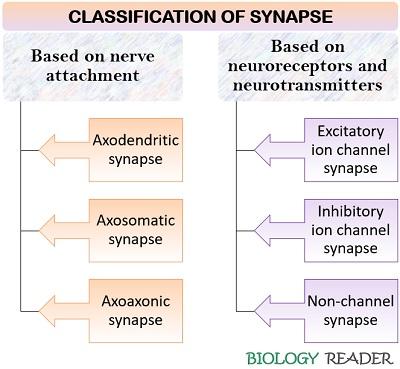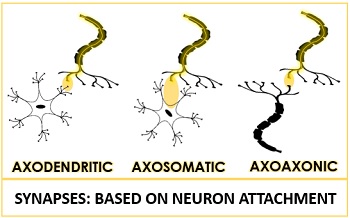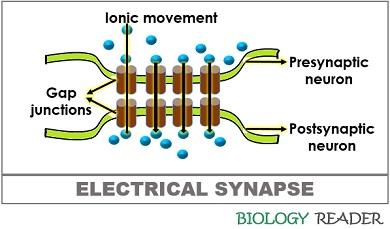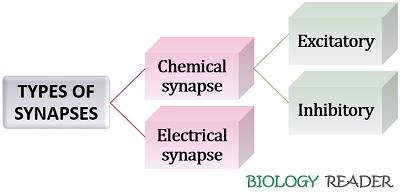Synapse is a term pioneered by Charles S. Sherrington in 1897. It is derived from the Greek word “Synapsis”, which means to conjugate or clasp. The communication between the neurons is through synapses only, which facilitate nerve signal transmission from one to the next cell.
A scientist named Sanford Palay observed the ultrastructure of neural tissue to prove the subsistence of synapse. Synapses function as a key junction in the nervous system, without which a signal cannot reach the brain directly.
Electrical synapses can directly pass the nerve impulse to neighbouring cells during the time of fast defence responses. On the other hand, chemical synapses involve the excitation of a nerve impulse that causes the release of neurotransmitters, which can carry the signal further via binding with specific cell receptors.
In this post, we will learn the definition, types (based on neuron attachment and presence of neuroreceptors and neurotransmitters) and function of the synapses. Also, the mechanism and diagram of electrical and chemical synapses have been explained.
Content: Synapse
Definition of Synapse
Synapses or neuronal junction refers to a region that conjugates and coordinates signal transmission activity between the two adjoining neurons. It forms a neuronal network to coordinate the tasks performed by the central nervous system and peripheral effector cells. Synapse has the following elements:
- The presynaptic terminal contains synaptic vesicles encapsulated around the neurotransmitter substance.
- Synaptic cleft refers to the 20 nm wide synaptic gap, which separates the two adjacent neurons.
- The postsynaptic terminal possesses receptor sites for the binding of neurotransmitters, which can either inhibit or promote the passage of nerve signal from one cell to the next.
Types of Synapses
Synapse is generally classified based on two attributes, one is the attachment of nerve fibres, and the other is the presence of neuroreceptors and neurotransmitters.

Based on the Attachment of Neurons
- Axodendritic: In this type, a synaptic junction is between the axon endings of one neuron and the dendritic spines of another neuron.
- Axosomatic: Here, synapses occur between the axon terminal of one nerve fibre with the soma or cell body of an adjacent neuron.
- Axoaxonic: In this kind, synapses occur in between axon’s terminal endings of the neighbouring neurons.

Based on the Type of Neurotransmitters and Neuroreceptors in Neurons
- Excitatory Ion Channel Synapses: It contains neuroreceptor in the form of sodium ion channels, which influx the electropositive sodium ions into the cytosol. The movement of sodium ions will depolarize the membrane potential inside the cytosol and generate the action potential respective to the stimulus.
For the conduction of an action potential, a stimulus should reach the maximum threshold. When an action potential reaches the presynaptic terminal, it will excite the synaptic vesicles (having neurotransmitters like acetylcholine, glutamate or aspartate) to fuse with the plasma membrane. The fusion facilitates the diffusion of neurotransmitters and stimulation of the adjacent neurons. - Inhibitory Ion Channel Synapses: It contains the neuroreceptor in the form of chloride channels, which influx the chloride ions into the cell cytoplasm. The movement of chloride ions will bring out hyperpolarization of the membrane potential and slow down the conduction of an action potential. Here, the diffusion of neurotransmitters from presynaptic neurons inhibits the postsynaptic neurons. It includes glycine or GABA as inhibitory neurotransmitters.
- Non-Channel Synapses: They possess neuroreceptors in the form of membrane-bound enzymes instead of ion channels. When the membrane-bound enzymes get activated by the neurotransmitters, they release the chemical messengers. The significant role of chemical messengers is to mediate long-lasting responses (learning and memory). They comprise neurotransmitters like acetylcholine, epinephrine, and dopamine etc.
Electrical Synapses
They produce nerve impulses, which can freely travel between the adjacent cells through gap junctions, without carrier molecules. Electrical synapses facilitate faster conduction of nerve signals.

It does not require neurotransmitters, and it can conduct the transmission of information bidirectionally. Here, the ions move vigorously through the tiny apertures between gap junctions.
The movement of ions occurs in a synchronized manner, without the collision of ions. The gap between electrical synapses is approximately 3.5 nm. Electrical signals are generally excitatory.
Destruction in signal strength occurs when it travels between the neighbouring neurons. To overcome the loss, it requires a big presynaptic neuron to excite a much smaller postsynaptic neuron.

Chemical Synapses
Here, the transmission occurs via a synaptic knob containing synaptic vesicles. The vesicles store chemical messengers (neurotransmitters). The fusion of vesicles release neurotransmitters outside the neuron.
 Along with carrier molecules or neurotransmitters, the nerve impulse crosses the membrane through the voltage-gated calcium channels. An opening of voltage-gated calcium channels allows a rapid influx of calcium ions.
Along with carrier molecules or neurotransmitters, the nerve impulse crosses the membrane through the voltage-gated calcium channels. An opening of voltage-gated calcium channels allows a rapid influx of calcium ions.
As a result, the concentration of calcium ions in the presynaptic neuron increases, which eventually cause the fusion of presynaptic vesicles with the plasma membrane.
It consequences the release of chemical messengers out of the neuron. Chemical synapse is further classifies into the excitatory and inhibitory synapse, based on its effect on nerve signal.
Excitatory Chemical Synapses
It promotes the propagation or conduction of an action potential. The binding of neurotransmitters to excitatory synapses leads to an opening of non-voltage gated channels.
It allows an influx of sodium or sometimes both sodium and potassium ions into the plasma membrane. The opening of the channel facilitates depolarization of the presynaptic plasma membrane, which generates an action potential.
Inhibitory Chemical Synapses
It inhibits the propagation or conduction of an action potential. The binding of neurotransmitter with inhibitory synapse results in an opening of potassium and chloride channels. Ultimately, it leads to the postsynaptic membrane’s hyperpolarisation that ceases the further movement of an action potential.
Synapse Function
The transmission of a nerve signal between the adjoining neurons is not a simple process. The nerve impulse must excite the synaptic vesicles to integrate them with the axon’s membrane. The dissolution of synaptic vesicles ensures the propagation of neurotransmitter molecules through exocytosis.
The chemical messengers or neurotransmitters further carry the nerve signal from the presynaptic terminal beyond the synaptic gap. Afterwards, the neurotransmitters bind with the specific cell receptors of the postsynaptic neuron or target cell. The action of neurotransmitter can be either inhibitory or excitatory, i.e. it may either excite or inhibit the neuron to which they bind with.
Here, we could take a reference of neurotransmitter with the key and cell receptors with a lock. Therefore, neurotransmitter functions as a key that can open or close the cell receptors. The specific binding of neurotransmitter with the cell receptor will initiate the further movement of the nerve signal.
Conclusion
Therefore, we can conclude that the synapses serve as the functional links between the neural network. It facilitates the transfer of nerve impulse from the nerve ending of the pre-synaptic neuron to the post-synaptic neuron. The transmission of nerve impulse generally occurs via electrical and chemical synapses.
Thanks a lot, this piece of info breaks things down to be more understanding.